Questions and Answers: May 2014
This is the most-read section of e-gardens each month. Neil invites you to send your question, but he does require that you also send a photo to accompany it. It will help him give you a more accurate answer if you’ll give him the city where you garden. He will choose questions of the greatest general reader interest to answer in the next issue of e-gardens. (Plant ID questions are usually of interest only to the writer.) Here then are this month’s questions and Neil’s answers.
Question: My Tiny Tower cypress trees are showing a lot of brown and dead branches. They’re mostly at the base, but the damage also moves upward. Several branches are green, others are grayish and still others brown and dead. Knockout roses planted between the cypresses are just fine. What causes this, and how can I stop it? M.P., Keller.
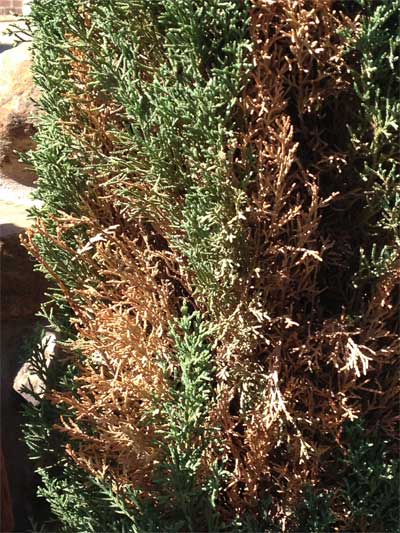
Answer: This is probably damage of spider mites. There is a species that attacks junipers and cypresses that starts working earlier than the mites that attack tomatoes and beans. These symptoms are characteristic for this pest (grayish-brown needles, starting at bottom of plant). Thump a suspect twig over a sheet of white paper. If you see nearly microscopic specks moving around, those are the mites. You may also want to try thumping another twig over a very dark piece of paper (e.g., a magazine ad with a good bit of black or dark blue ink). Sometimes these mites are very light-colored. General-purpose insecticides are about your only hope of a control, but you’ll need to spray as quickly as possible. This damage is already looking pretty bad.
Question: Our star jasmine’s leaves started turning brown a few weeks ago. What would have caused this? S., Jacksonville, TX.
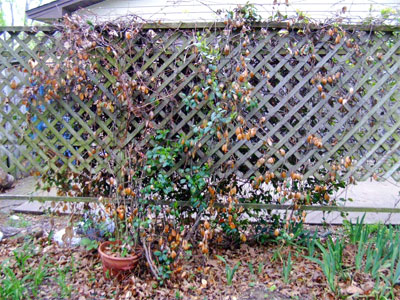
Answer: This is freeze damage, and it’s been widespread across the northern half of Texas this spring. Star jasmine is less winter-hardy than our Asian jasmine groundcover. Trim out the dead growth and allow the vines to regrow. Yours probably will, but many of the star jasmine plants I’ve seen closer to DFW have been killed out completely.
Question: I had bermudagrass in my Asian jasmine groundcover last summer. I understand that glyphosate weedkiller will get rid of it. When should I apply it? T.G., no city given.
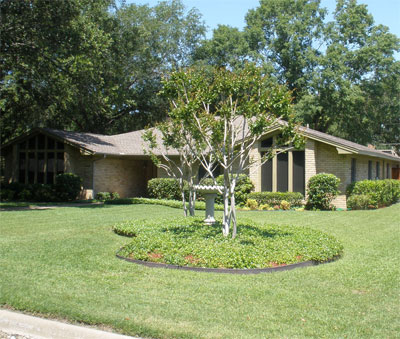
Answer: Since glyphosate labels don’t list this as an approved use of the weedkiller, I can’t officially recommend it to you. However, I will tell you that I have seen it used hundreds of times with very good results, and I’ve even used it myself very successfully. I used the glyphosate at the strength recommended for killing grasses, and I applied it in late June, once the Asian jasmine leaves had turned leathery and dark green. I would be afraid to try it while the jasmine was bright green and growing vigorously. I have not seen any type of damage to the jasmine when those steps are followed, and the bermuda is almost always eliminated. Note: other types of groundcovers will be killed by the glyphosate, so limit this treatment to Asian jasmine, and try a small test area first, to be sure the results are as you expect. You’ll see the grass dying within a couple of weeks.
Question: I have had these Japanese boxwoods for 10 years, and they have always been healthy. Do you have any idea what might have caused this, and will they recover? H.S., no city given.
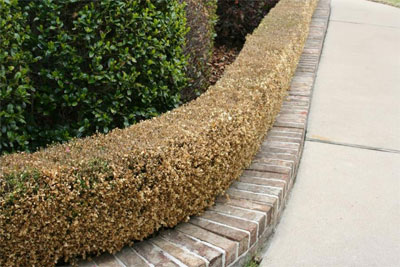
Answer: Wow! Whatever attacked them got them all. It would be immensely helpful to have known where you are. Nematodes (microscopic soil-borne worms that attack boxwood roots) would have been much more spotty. Lace bug damage would have shown up eight months ago, so you would have asked then. This could be drought damage, although again, you would have said something earlier. It could be freeze damage, but that would only be if you are in a very cold part of Texas. These plants, because of the brick retainer, are somewhat more exposed than they would have been if they were in the ground. So, by process of elimination, I’m going to have to guess cold injury. I don’t know if they’ll come back, but you can probably determine that yourself very soon.
Question: Our house is about 25 years old, and the landscape is probably the same. I feel that the plants obscure our entryway too much, and I’d like to prune them back to open it up. Can I do that? I also notice that the azalea is a little leggy looking. I’d rather not go to the expense and effort of redoing things, but do shrubs have life expectancies in a landscape? J.H., The Woodlands.
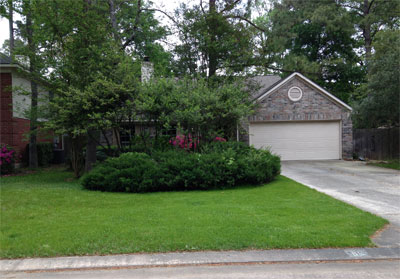
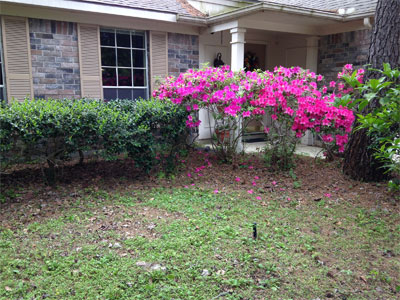
Answer: It would appear from the front view of your home that you could selectively remove and thin some of the growth, but it’s going to involve a good bit of hand-pruning with shears and loppers. It’s almost impossible to give you suggestions without being on-site to demonstrate. I always remove a few branches at a time, so that I can see the results of my pruning before I go too far. As for the azaleas and the shrubs that are near them, this area looks very shady. That really contributes to the stretched growth of the plants. The thinning turf is another clue. I know you don’t want to redo the landscape, but pruning plants “back” time after time won’t solve the problem. These plants have the genetic predetermination to grow to certain heights, and when they are pruned repeatedly, they begin to lose vigor. My wife and I have lived in the same house for 37 years. I have a couple of beds that have been redone twice already. It’s a very difficult decision, but I’m always glad when I’ve taken the step. Mine also involved azaleas that had become leggy.
Question: This unusual growth is on several of our crape myrtles this year. Is it anything we should worry about? W.K., Woodville.
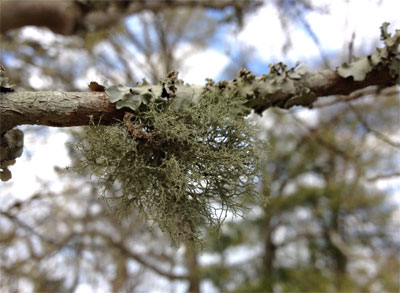
Answer: These are lichens. They are colonized growths of algae and funguses, and they are harmless to the plants on which they are growing. In fact, they are also found growing on large landscape boulders (“moss-covered” rocks). No worry. No call to action.
Question: Is there a small accent tree that would grow in dappled shade on the west side of my house? It looks really bare. M., Waco.
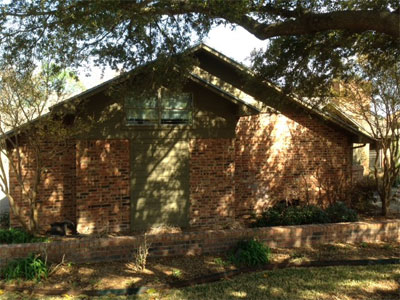
Answer: I have tried to see the area and the distances involved, but I’m having to guess just a bit. This is really very heavy shade for most types of trees. I would suggest a tree-form yaupon holly if there is enough room. It would grow to be 15 to 18 feet tall and wide. A Japanese maple would probably do well if the area is shaded all afternoon long. Japanese maples are available in sizes ranging from shrub-like to 25-foot trees. Your nurseryman could show you the options. Nellie R. Stevens holly in tree form (you may have to train it yourself), or a pyramidal Oakland holly would be good. I hope this is of help. Let your nurseryman have the last vote, perhaps with the advantage of having several additional photos from different angles.
Question: Our lawn is coming in nicely, except for patches that we feel might be Take All Root Rot. It started showing up last July. Our yard man said it is probably a fungus, and he spread peat over it. That seemed to stop it. We have experienced this two consecutive summers, but we did not get the peat moss spread until August last year. What is your recommendation? B. and C.C., Arlington.
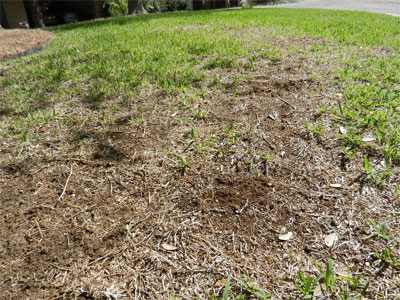
Answer: I don’t believe this is Take All Root Rot. TARR is a spring disease (April and May), usually abating by the time it gets hot. My bet would be that this is chinch bug damage. They attack St. Augustine in July and August, always in the hottest, sunniest part of the yard. TARR is spread throughout the lawn, without regard to sun and shade. Chinch bugs come back at the same time each summer, also to the same places in the lawn. You applied the peat in August, but the chinch bugs quit feeding by early September, so you would get the impression that the peat had solved the problem, when in reality it was probably just the beginning of the seasonal change. In either case, you’re going to need to dig plugs and replant them into those dead areas now.
Question: I planted my new holly in October, and it looks awful. The top has died back. Other branches look better. What might have caused it? J.A., Alvord.
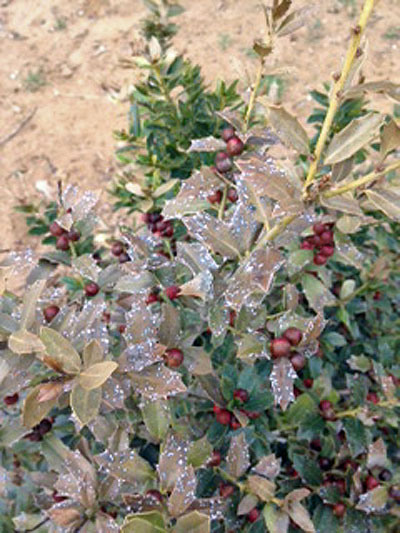
Answer: This plant got too dry at some point. It’s also possible that the extreme weather conditions added to the problem. It would normally be completely winter-hardy for you in your area, but if the plant happened to be dry at the time of the cold, those factors could have doubled up to cause this damage.
Question: I was working with a survey crew in Brazos County when we came across this orange growth on the trunks of trees in a particular grove. It looks like some type of florescent foam. None of us had ever seen anything like it. Any ideas? M.W., Dallas.
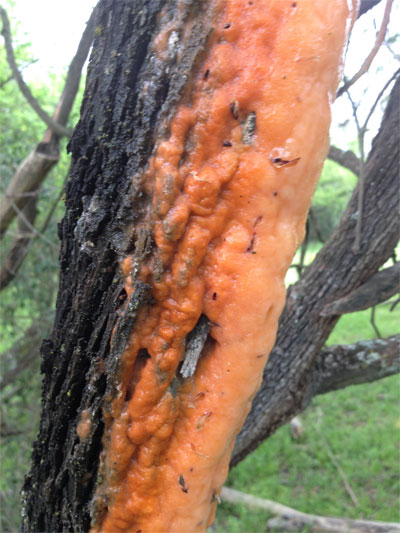
Answer: This is really interesting. It’s probably a saprophytic fungus that is living off the decaying organic matter. It could be a rust, somewhat similar to cedar-apple rust. In any event, it appears that the trunks in your photos are dead wood. No cause for concern. I’ve learned to admire nature’s incredible array of plant life. (Yep. This is a lower form of plant life.)
Question: I have property near the Red River. This is a photo of a cedar bush/tree. The bottom part grew very slowly, but then suddenly more normal growth spurted out. What’s going on? G., Southeastern Oklahoma.
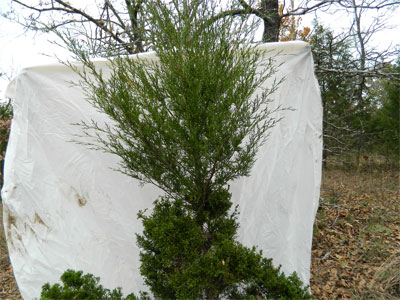
Answer: It’s obvious to me! Your plant spotted Texas and started to grow right toward it. Kidding aside, I have to admit that this isn’t a common thing. Our native plant is eastern redcedar juniper, Juniperus virginiana. There are several selections in the nursery trade that have been made from unusual growth forms of it. That must be what happened to the bottom of this plant. Then it reverted to the straight species with this vigorous growth. If you wanted to trim out the normal growth and watch the bottom continue to develop, it might be interesting.
Question: I am buying three cast stone planters for my patio. However, they do not have drain holes. Should I try to drill holes, or maybe use a layer of charcoal? I would like to grow fig ivy in them. Would covering the plants with fabric protect them in the winter? B.H., Farmers Branch.
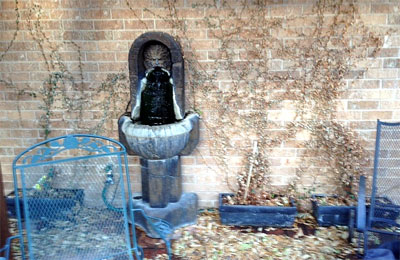
Answer: Charcoal doesn’t improve the drainage, just as it wouldn’t help a stopped up bathtub start to drain. I’m not a big fan of trying to drill holes in containers. I try to buy types that already have holes. However, I have been successful in drilling in the past, and if you use a masonry bit, a variable speed drill (on “slow”) and lots of water for lubrication, you can drill into most types of surfaces. Be patient. Not a time to hurry. As for winter protection, you might gain a few degrees of protection, but since the vine would be so far off the ground, the warming of the soil beneath the frost cloth would probably be minimal. Fig ivy is marginally hardy in the urban heat pocket of DFW. The farther you get outside the downtown areas, the less likely it is to survive. We’ve been lucky for several winters (until this year).
